
Understanding Legal Remedies: Exploring the Most Common Options Available
Welcome to this informative article on understanding legal remedies in the United States. It is important to note that while we strive to provide accurate and reliable information, it is always advisable to cross-reference with other sources or consult with legal advisors for specific legal matters.
When faced with a legal dispute or harm caused by someone else’s actions, you may be wondering what options are available to seek justice and resolution. Legal remedies are the means by which individuals can resolve disputes, enforce rights, and obtain compensation for any harm suffered. Let’s explore some of the most common legal remedies available in the US:
📋 Content in this article
1. Compensatory Damages: This is the most common type of remedy sought in civil lawsuits. Compensatory damages aim to compensate the injured party for the harm they have suffered, both monetarily and non-monetarily. These damages can include medical expenses, lost wages, property damage, pain and suffering, and emotional distress.
2. Equitable Remedies: In certain cases, compensatory damages may not be enough to provide complete justice. Equitable remedies come into play when monetary compensation alone cannot adequately address the harm suffered. Examples of equitable remedies include injunctions (court orders that require or prohibit certain actions), specific performance (requiring a party to fulfill their contractual obligations), and declaratory judgments (determining the rights and obligations of the parties involved).
3. Restitution: Restitution is a remedy focused on restoring the injured party to the position they were in before the harm occurred. It involves the return of property or funds wrongfully taken, as well as the disgorgement of profits obtained through illegal means.
4. Punitive Damages: Unlike compensatory damages that aim to make the injured party whole again, punitive damages are intended to punish the wrongdoer and deter similar conduct in the future
Understanding the Most Common Type of Legal Remedy: A Comprehensive Guide
Understanding Legal Remedies: Exploring the Most Common Options Available
When dealing with legal disputes, it is crucial to understand the various legal remedies that may be available to you. A legal remedy is a solution provided by a court of law to address a particular harm or injustice. These remedies can take many forms, depending on the nature of the dispute and the desired outcome.
To help you navigate the often complex world of legal remedies, this comprehensive guide will explore the most common options available in the United States legal system. It is important to note that this guide provides general information and does not constitute legal advice. Consulting with a qualified legal professional is always recommended when seeking a legal remedy for your specific situation.
1. Monetary Damages
One of the most common types of legal remedy is monetary damages. This involves the payment of money by the party found to be at fault to compensate for the harm caused. Monetary damages can cover various losses, including medical expenses, property damage, lost wages, and pain and suffering. There are three main types of monetary damages:
2. Injunctive Relief
Another common legal remedy is injunctive relief,
Understanding Common Remedies in US Law: A Comprehensive Overview
Understanding Legal Remedies: Exploring the Most Common Options Available
In the realm of US law, legal remedies are the means by which a court seeks to address a legal wrong or provide compensation for harm caused. These remedies are essential for ensuring justice and maintaining the rule of law. In this article, we will explore the most common options available as legal remedies in the United States.
1. Monetary Damages:
2. Injunctive Relief:
3. Specific Performance:
Understanding Legal Remedies: Exploring the Most Common Options Available
In the field of US law, it is crucial for both legal professionals and individuals to have a comprehensive understanding of legal remedies. Legal remedies refer to the actions that can be taken to address a legal wrong or seek compensation for damages. These remedies play a vital role in ensuring justice and fairness in the legal system.
It is important to stay current on the topic of legal remedies due to the ever-evolving nature of the law. Laws change, precedents are set, and new interpretations emerge. Therefore, this article aims to provide an overview of the most common legal remedies available in the US legal system. However, readers should always verify and cross-reference the information provided here to ensure its accuracy and applicability to their specific jurisdiction.
1. Monetary Damages:
Monetary damages are one of the most common legal remedies sought in civil cases. This remedy aims to compensate the injured party for losses suffered as a result of another party’s wrongful conduct. There are different types of monetary damages, including:
– Compensatory Damages: These damages aim to reimburse the injured party for actual losses, such as medical expenses, lost wages, property damage, or pain and suffering.
– Punitive Damages: In cases where the defendant’s behavior is particularly egregious or malicious, punitive damages may be awarded. The purpose of punitive damages is to punish the wrongdoer and deter others from engaging in similar behavior.
2. Injunctive Relief:
In some situations, monetary compensation may not be sufficient to address a legal wrong adequately. In such cases, injunctive relief may be sought. Injunctive relief refers to a court order that compels or prohibits a certain action. It aims to prevent further harm or force compliance with a specific legal obligation. Examples of injunctive relief include restraining orders, cease and desist orders, or temporary restraining orders.
3.
